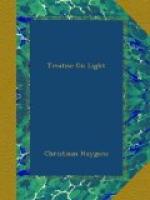[Illustration]
Let KF be the plane surface; A the point in the medium which the light traverses more easily, as the air; C the point in the other which is more difficult to penetrate, as water. And suppose that a ray has come from A, by B, to C, having been refracted at B according to the law demonstrated a little before; that is to say that, having drawn PBQ, which cuts the plane at right angles, let the sine of the angle ABP have to the sine of the angle CBQ the same ratio as the velocity of light in the medium where A is to the velocity of light in the medium where C is. It is to be shown that the time of passage of light along ab and bc taken together, is the shortest that can be. Let us assume that it may have come by other lines, and, in the first place, along AF, FC, so that the point of refraction F may be further from B than the point A; and let Ao be a line perpendicular to ab, and FO parallel to ab; BH perpendicular to FO, and FG to bc.
Since then the angle HBF is equal to PBA, and the angle BFG equal to QBC, it follows that the sine of the angle HBF will also have the same ratio to the sine of BFG, as the velocity of light in the medium A is to its velocity in the medium C. But these sines are the straight lines HF, BG, if we take BF as the semi-diameter of a circle. Then these lines HF, BG, will bear to one another the said ratio of the velocities. And, therefore, the time of the light along HF, supposing that the ray had been of, would be equal to the time along BG in the interior of the medium C. But the time along ab is equal to the time along Oh; therefore the time along of is equal to the time along ab, BG. Again the time along FC is greater than that along GC; then the time along OFC will be longer than that along abc. But AF is longer than of, then the time along AFC will by just so much more exceed the time along abc.
Now let us assume that the ray has come from A to C along AK, kc; the point of refraction K being nearer to A than the point B is; and let CN be the perpendicular upon bc, KN parallel to bc: BM perpendicular upon KN, and Kl upon Ba.




